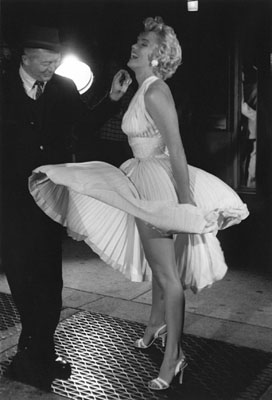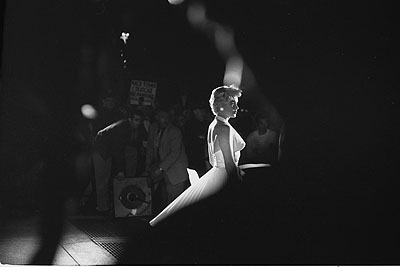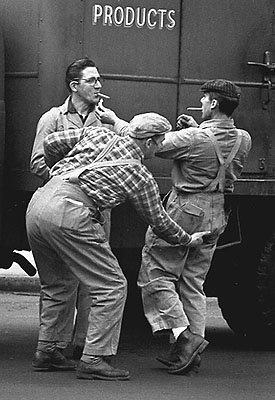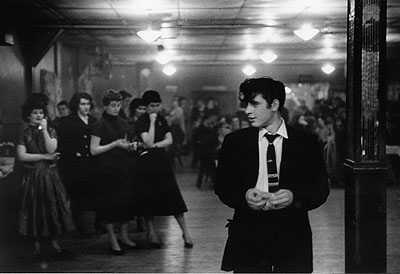
George S. Zimbel. All Rights reserved.
George S. Zimbel »
ENERGY
Exhibition: 9 Apr – 31 May 2008
Kowasa Gallery
Mallorca 235
08008 Barcelona
+34 (0)93-4873588
galeria@kowasa.com
www.kowasa.com
Tue-Sat 16:30-20:30

George S. Zimbel. All Rights reserved.
KOWASA gallery presents a retrospective show dedicated to the American-Canadian documentary photographer George S. ZIMBEL. Zimbel is a key figure of the last generation of authors faithful to the legacy of Photo-League, who in the fifties imbued their pictures with their personal commitment towards the people and the social landscapes they documented. The show offers the unique opportunity of discovering the work of an author who captured with his camera the energy and the spirit of the “era of innocence” before its imminent end with the Vietnam War.
New York and New Orleans alongside portraits of emblematic celebrities such as John Kennedy, Marilyn Monroe and Leonard Bernstein... More than sixty B/W photographs, all printed by Zimbel, offer a thorough insight to the various periods of his extensive trajectory that covers more than half a century, from the early fifties to our days.
Born in Woburn, Massachusetts in 1929, George S. Zimbel made his first steps into photography when still in his early teens. At the age of fourteen he bought his first professional camera and took up assignments for a local newspaper. During his studies at Columbia University in New York City, Zimbel was appointed both photographer and editor in the university newspaper. He even published an image in LIFE magazine. In 1949, Zimbel became a stringer for both the PIX Agency and Newsweek and studied the darkroom with John Ebstel in the Photo-League. He also formed the “Midnight to Dawn Club” with his close friend Garry Winogrand. The two young men would spend the whole night in the university darkroom. In the morning Winogrand would go back home to the Bronx to get some rest, while Zimbel would go directly to class.
After graduation, Zimbel attended on scholarship Alexey Brodovitch’s Workshop in New York. In 1951, he presented his portfolio to Edward Steichen, the then director of the photography department in the MoMA. Steichen’s assistant, Grace Mayer, introduced him to many photographers and urged him to study the photographic collection of themuseum. During his military service in 1951-1953, Zimbel took pictures of various cities in Germany, France, Italy and England. In 1953 he came back to New York to embark on his career as a freelance photographer, realizing photographic essays for various magazines and publications, such as The New York Times, Look, Pageant, Saturday Review and Architectural Forum.
His snapshots of that era of the streets, the neighborhoods, the children of NY and the nightclubs of the legendary Bourbon Street in New Orleans demonstrate the simplicity, the elegance and the charm of a daily life which no longer exists. With a precision and a sensibility, which goes much further than a sensationalist attitude or a cold gaze, Zimbel documented some of the most emblematic moments of American history. He also portrayed personalities such as Leonard Bernstein, Hellen Keller, Mickey Rooney and Jean Seberg, alongside the Presidents Harry S. Truman (in the famous series “A President in Retirement”), John and Jacqueline Kennedy, Dwight D. Eisenhower and Richard M. Nixon. Zimbel also became one of the photographers who took pictures of Marilyn Monroe in the mythical session “The Seven Year Itch” in 1954.
Faithful to his mission as an observer, Zimbel believes in non-intervention. Guided by a conscious determination, his images offer a completely subjective interpretation based on the respect towards his subjects, the critical observation and the spontaneous action. However, the poetic flair emerging from his images has to do more with his own sensibility, which always helps him achieve a balance between the chance and the ambiguity of life, rather than his labor as a visual historian and researcher. This very same sensibility combined with his extraordinary social awareness orientated him towards photographic projects related to the fields of architecture and education, away from the established commercial paths. In the years to come, his commitment towards his personal values would become even firmer. In 1971 Zimbel decided to emigrate with his family from the States to Canada, expressing in this way his opposition to the War of Vietnam and to the climate of political tension the country was undergoing. In 1977 he obtained the Canadian nationality.
Zimbel had his first major exhibition in 1976 at the Confederation Centre Art Gallery-Museum in Prince Edward Island, Canada. Since the eighties, when he took up full-time freelance work in Montreal, his work started to appear in various shows: in The Photographer’s Gallery (London, 1992), in MoMA (New York, 1994), in the Stephen Bulger Gallery (Toronto, 1999-2002), in Columbia University (2001), in the Canadian Embassy of Tokyo and in the Brooklyn Museum (2005). In 2000, the IVAM Centre Julio Gonzalez in Spain organized his largest monographic exhibition. Apart from being part of many private collections, Zimbel’s work can also be found in collections of big institutions, such as The National Gallery of Canada, The Museum of Modern Art and The International Center of Photography in New York, the Houston Museum of Fine Arts, the Tokyo Metropolitan Museum of Photography, the Musée National des Beaux Arts du Québec, the Musée d´art contemporain de Montreal and the Brooklyn Museum. Two books have been published on the photographer: George S. ZIMBEL. IVAM Centre Julio Gonzalez, 2000 (exhibition catalogue with photographs and poems by Zimbel) and ZIMBEL, George S, Bourbon Street. New Orleans 1955. Les Éditions du Passage, Québec, 2006. In 2005, Zimbel was inducted into the Royal Canadian Academy of Arts.
George S. Zimbel still remains active. He always opts for assignments and subjects that interest him most and do not interfere with his ideology and he spends a great part of his time in his darkroom printing negatives of his archive.

George S. Zimbel. All Rights reserved.

George S. Zimbel. All Rights reserved.